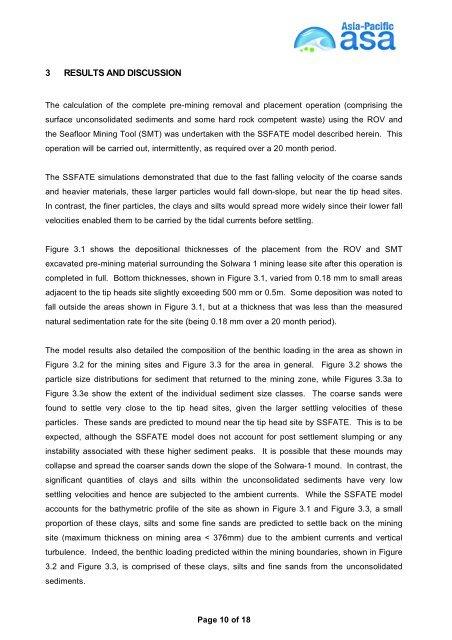Appendices 5-13 - Nautilus Cares - Nautilus Minerals
Appendices 5-13 - Nautilus Cares - Nautilus Minerals
Appendices 5-13 - Nautilus Cares - Nautilus Minerals
You also want an ePaper? Increase the reach of your titles
YUMPU automatically turns print PDFs into web optimized ePapers that Google loves.
3 RESULTS AND DISCUSSION<br />
The calculation of the complete pre-mining removal and placement operation (comprising the<br />
surface unconsolidated sediments and some hard rock competent waste) using the ROV and<br />
the Seafloor Mining Tool (SMT) was undertaken with the SSFATE model described herein. This<br />
operation will be carried out, intermittently, as required over a 20 month period.<br />
The SSFATE simulations demonstrated that due to the fast falling velocity of the coarse sands<br />
and heavier materials, these larger particles would fall down-slope, but near the tip head sites.<br />
In contrast, the finer particles, the clays and silts would spread more widely since their lower fall<br />
velocities enabled them to be carried by the tidal currents before settling.<br />
Figure 3.1 shows the depositional thicknesses of the placement from the ROV and SMT<br />
excavated pre-mining material surrounding the Solwara 1 mining lease site after this operation is<br />
completed in full. Bottom thicknesses, shown in Figure 3.1, varied from 0.18 mm to small areas<br />
adjacent to the tip heads site slightly exceeding 500 mm or 0.5m. Some deposition was noted to<br />
fall outside the areas shown in Figure 3.1, but at a thickness that was less than the measured<br />
natural sedimentation rate for the site (being 0.18 mm over a 20 month period).<br />
The model results also detailed the composition of the benthic loading in the area as shown in<br />
Figure 3.2 for the mining sites and Figure 3.3 for the area in general. Figure 3.2 shows the<br />
particle size distributions for sediment that returned to the mining zone, while Figures 3.3a to<br />
Figure 3.3e show the extent of the individual sediment size classes. The coarse sands were<br />
found to settle very close to the tip head sites, given the larger settling velocities of these<br />
particles. These sands are predicted to mound near the tip head site by SSFATE. This is to be<br />
expected, although the SSFATE model does not account for post settlement slumping or any<br />
instability associated with these higher sediment peaks. It is possible that these mounds may<br />
collapse and spread the coarser sands down the slope of the Solwara-1 mound. In contrast, the<br />
significant quantities of clays and silts within the unconsolidated sediments have very low<br />
settling velocities and hence are subjected to the ambient currents. While the SSFATE model<br />
accounts for the bathymetric profile of the site as shown in Figure 3.1 and Figure 3.3, a small<br />
proportion of these clays, silts and some fine sands are predicted to settle back on the mining<br />
site (maximum thickness on mining area < 376mm) due to the ambient currents and vertical<br />
turbulence. Indeed, the benthic loading predicted within the mining boundaries, shown in Figure<br />
3.2 and Figure 3.3, is comprised of these clays, silts and fine sands from the unconsolidated<br />
sediments.<br />
Page 10 of 18


